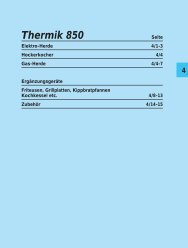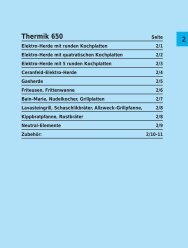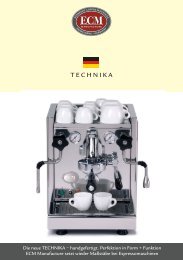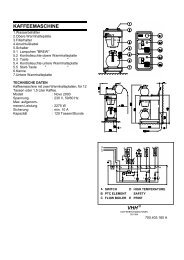Office Leva EX 237 2 Kessel
Office Leva EX 237 2 Kessel
Office Leva EX 237 2 Kessel
Create successful ePaper yourself
Turn your PDF publications into a flip-book with our unique Google optimized e-Paper software.
selected fineness of the setting. The finest settings may create a powdery grind, which<br />
produces tiny balls or causes the grinds to stick in the chute or doser. Worse, too fine a<br />
grind may prevent the water from penetrating the puck at all.<br />
On the other hand, too coarse a grind adversely affects shot quality and diminishes the<br />
amount of the desired crema and flavor. The only solution is to experiment to determine<br />
which settings are the right ones for your grinder, beans and ambient conditions. Bear in<br />
mind the grind should most often imitate very fine sand, not a silky powder.<br />
Tip: While standard food scales tend to be inexact as well as bulky, there is another class<br />
of scales known as pocket scales. These tiny precision wonders are usually accurate to ±<br />
1/10 th of a gram. Some people will put the basket on the scale’s platform and for every<br />
shot grind 14 grams directly into it, then transfer it to the handle, which has been heating<br />
in the group head. Others fill a small container on the scale and then fill the heated<br />
basket.<br />
Note: If you elect to dose into the basket itself each time then you will have to contend<br />
with the issue of the spring in the portafilter, which holds the basket very tightly in place.<br />
It will need to be adjusted for tension or removed entirely to use this method successfully.<br />
Thus, grinding directly into the basket in the handle without removing it, and then<br />
tamping, may work the best for you—but be sure to work quickly so heat is not lost.<br />
Still another option is to weigh each dose until the grinder is properly calibrated for the<br />
dose amount. You will have to do this often with changes in the weather, grind setting or<br />
different batches of roasted beans. In the end, many people simply learn to determine<br />
what a reasonable approximation of what 14 grams looks like in the basket. With<br />
practice, this method can become surprisingly accurate.<br />
Others like to overfill the basket and use a straight edge to level off before tamping. This,<br />
however, is quite messy and surely a waste of good coffee and does not necessarily<br />
assure an accurate dose.<br />
It is important to remember that consistency with each step builds a professional<br />
foundation of accuracy, so choose a routine you like and stay with it.<br />
Tamping: Much has been written about this subject and its importance. The David<br />
Schomer method seems to be the most widely adopted tamping method. Quite simply, it<br />
involves distributing the grounds in north, south, east and west directions with the finger<br />
until they are level and even but with a slight indentation or well in the center. Then a 30<br />
to 40 pound tamp is delivered straight down with a twisting motion. After carefully<br />
removing the tamper, lightly tap the side of the filter or basket with the tamper to<br />
dislodge any loose grounds. Tamp and polish again. Sometimes three tamps may be<br />
required. To test your tamp pressure, practice with a bathroom scale.<br />
Now you are ready to return the basket or filter handle to the brew head and begin your<br />
shot. If you have done the tamp step correctly you have successfully minimized the<br />
19






